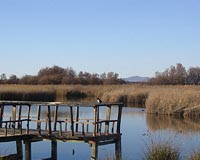| . |  |
. |
Washington DC (SPX) Feb 04, 2010 Speed is not a word typically associated with trees; they can take centuries to grow. However, a new study to be published the week of Feb. 1 in the Proceedings of the National Academy of Sciences has found evidence that forests in the Eastern United States are growing faster than they have in the past 225 years. The study offers a rare look at how an ecosystem is responding to climate change. For more than 20 years forest ecologist Geoffrey Parker has tracked the growth of 55 stands of mixed hardwood forest plots in Maryland. The plots range in size, and some are as large as 2 acres. Parker's research is based at the Smithsonian Environmental Research Center, 26 miles east of the nation's capital. Parker's tree censuses have revealed that the forest is packing on weight at a much faster rate than expected. He and Smithsonian Tropical Research Institute postdoctoral fellow Sean McMahon discovered that, on average, the forest is growing an additional 2 tons per acre annually. That is the equivalent of a tree with a diameter of 2 feet sprouting up over a year. Forests and their soils store the majority of the Earth's terrestrial carbon stock. Small changes in their growth rate can have significant ramifications in weather patterns, nutrient cycles, climate change and biodiversity. Exactly how these systems will be affected remains to be studied. Parker and McMahon's paper focuses on the drivers of the accelerated tree growth. The chief culprit appears to be climate change, more specifically, the rising levels of atmospheric CO2, higher temperatures and longer growing seasons. Assessing how a forest is changing is no easy task. Forest ecologists know that the trees they study will most likely outlive them. One way they compensate for this is by creating a "chronosequence"-a series of forests plots of the same type that are at different developmental stages. At SERC, Parker meticulously tracks the growth of trees in stands that range from 5 to 225 years old. This allowed Parker and McMahon to verify that there was accelerated growth in forest stands young and old. More than 90% of the stands grew two to four times faster than predicted from the baseline chronosequence. By grouping the forest stands by age, McMahon and Parker were also able to determine that the faster growth is a recent phenomenon. If the forest stands had been growing this quickly their entire lives, they would be much larger than they are. Parker estimates that among himself, his colleague Dawn Miller and a cadre of citizen scientists, they have taken a quarter of a million measurements over the years. Parker began his tree census work Sept. 8, 1987-his first day on the job. He measures all trees that are 2 centimeters or more in diameter. He also identifies the species, marks the tree's coordinates and notes if it is dead or alive. By knowing the species and diameter, McMahon is able to calculate the biomass of a tree. He specializes in the data-analysis side of forest ecology. "Walking in the woods helps, but so does looking at the numbers," said McMahon. He analyzed Parker's tree censuses but was hungry for more data. It was not enough to document the faster growth rate; Parker and McMahon wanted to know why it might be happening. "We made a list of reasons these forests could be growing faster and then ruled half of them out," said Parker. The ones that remained included increased temperature, a longer growing season and increased levels of atmospheric CO2. During the past 22 years CO2 levels at SERC have risen 12%, the mean temperature has increased by nearly three-tenths of a degree and the growing season has lengthened by 7.8 days. The trees now have more CO2 and an extra week to put on weight. Parker and McMahon suggest that a combination of these three factors has caused the forest's accelerated biomass gain. Ecosystem responses are one of the major uncertainties in predicting the effects of climate change. Parker thinks there is every reason to believe his study sites are representative of the Eastern deciduous forest, the regional ecosystem that surrounds many of the population centers on the East Coast. He and McMahon hope other forest ecologists will examine data from their own tree censuses to help determine how widespread the phenomenon is. To read the article in full click here
Share This Article With Planet Earth
Related Links Smithsonian Forestry News - Global and Local News, Science and Application
 Heavy rains bring Spanish wetlands back to life
Heavy rains bring Spanish wetlands back to lifeMadrid (AFP) Feb 2, 2010 An environmentally valuable expanse of Spanish wetlands that dried up through mismanagement of water resources and drought is once again awash with water due to heavy rainfall, an official said Tuesday. Over 1,200 hectares (3,000 acres) of the wetlands of the Tablas de Daimiel National Park are flooded, the highest level since 1997, up from just 67 hectares on January 7, a park spokesman sai ... read more |
|
| The content herein, unless otherwise known to be public domain, are Copyright 1995-2010 - SpaceDaily. AFP and UPI Wire Stories are copyright Agence France-Presse and United Press International. ESA Portal Reports are copyright European Space Agency. All NASA sourced material is public domain. Additional copyrights may apply in whole or part to other bona fide parties. Advertising does not imply endorsement,agreement or approval of any opinions, statements or information provided by SpaceDaily on any Web page published or hosted by SpaceDaily. Privacy Statement |